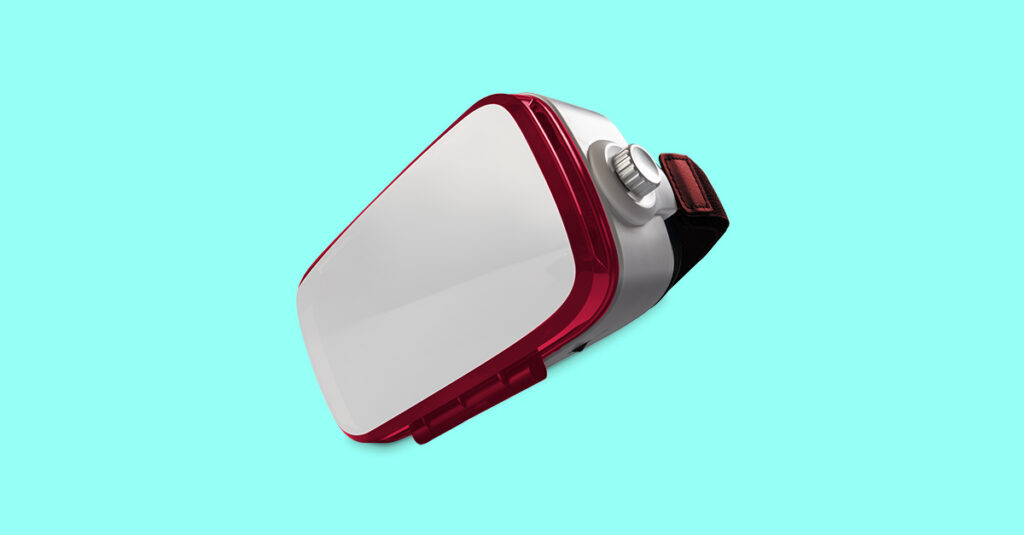
Choosing the Right VR Headset
Whatever way you use virtual reality (VR)—for gaming, education, work—you experience it by wearing a headset, sometimes called VR goggles, which typically fits over your head and covers your eyes. These headsets make it feel like you’re really part of the game, classroom, workout or even meeting by their small, extremely high-resolution screens that create an immersive experience. The technology has come a long way since its roots in the 1830s (!), with manufacturers like Meta (formerly Facebook), HTC and Sony releasing powerful hardware that lets users explore other worlds.
Choosing the right headset depends on your goals and the hardware you already have. This guide outlines what to look for to get the best VR headset for you.
How much does a VR headset cost?
Headsets are available at every price point, with corresponding specs. Just want to dip your toe in? A Google Cardboard will run you 8 to 30 bucks and only requires a smartphone. The Verge notes that this experience is not for multi-hour sessions, but for short-form video or trying other Cardboard-specific apps.
Diving into VR can get costly. The Meta Quest 2 (formerly Oculus Quest), which doesn’t require a smartphone or a PC, starts at around $300. The best VR headsets for PC, like the high-power HTC Vive Pro, Valve’s Index and others can rise above $1,000 when you include accessories. Of course, you can nab an inexpensive VR headset for PC gaming by buying used or prior-generation tech.
How to compare VR headsets
VR is a bustling industry, with new hardware announced all the time. Here are the major specs to look for:
- Screens – Pay attention to the refresh rate and resolution—the higher the numbers, the better, more immersive and lifelike the experience is.
- Field of view – Measured in degrees, this refers to the “width” of visible content you can see through the headset. You generally want at least 100º.
- Wires – Want wireless? The Meta Quest is the way to go right now. Otherwise, the best VR headsets in 2022 are “tethered,” meaning they have wires to connect them to another device (a PC or PlayStation). If you want to move around, this may constrain your options.
- Speed/lag – Refresh rate helps with lag, as does processing power—and that’s the tradeoff with wires. If you’re wired to a powerful PC or console, your headset can do more.
- Controllers – Many popular headsets include controllers, but HTC’s Vive Pro, one of the industry’s favorites, requires a separate purchase.
- Platform compatibility – Quest devices are standalone or compatible with PCs with an optional cable; headsets like Valve’s Index and HTC’s Vive require a highly specced PC; and PlayStation VR requires a PlayStation 4 or 5. PCMag notes that smartphone-compatible VR isn’t as common as it was a few years ago.
What are VR base stations?
Base stations are external devices that sense your headset and controllers and improve motion tracking. They can add significantly to your startup costs, but depending on your purpose, base stations may not be required. If your VR use entails being stationary, you’ll be fine without them. You may not need them for meetings, certain fitness applications or “cockpit” VR games.
How do I choose the best VR headset for fitness?
If fitness is your goal, you likely want a headset that enables movement. Choose either a wireless headset, or make sure it has wires long enough to let you move around your space. Once you’ve decided, check out Greatist for some recommendations for VR fitness games.
Can I wear a VR headset with glasses?
Yes. Most manufacturers include tips for wearing glasses comfortably with your headset, and Upload put together this handy guide.
Where can I buy a VR headset?
Most VR headsets can be purchased online, but if they’re not available or if you want to try before you buy, Best Buy and GameStop are good bets.
What if I have an older VR headset?
If you have a VR headset now, you may already know what you like and what you don’t. In the past few years, hardware has gotten better and less expensive: faster processors, fewer wires, nicer screens. If you can already do everything you want, you might not need a new headset yet, but if you want a more immersive experience, it might be time to take another look.
How long does it take to adjust to VR headsets?
Some headsets are heavy and may not be comfortable to wear for a long time. It’s also not uncommon to experience some motion sickness with VR headsets, though manufacturers are working on addressing this. The time to adjust (if any) will vary by the person, but check out some tips to speed it along.
Can I use VR for conferences and other work uses?
Analysts predict that VR will shake up the work world by enabling greatly enhanced virtual meetings and conferences. The best conference headset could be a lower-tech (and lower-cost!) setup than what a hardcore gamer requires.
Can I use VR for streaming video?
Content creators are building a library of 360º VR video on YouTube and elsewhere. You need a great internet connection, ideally fiber, to get the best results when you’re uploading or downloading VR video.



